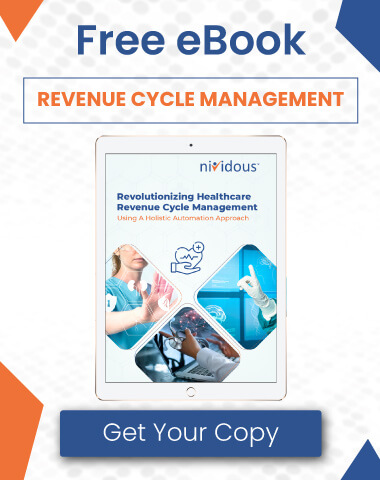In the U.S. healthcare system, collecting payments isn’t as simple as sending an invoice and receiving a check. Providers have to determine who owes what, and with the nation’s sprawling insurance market, that takes time. They must schedule appointments, navigate medical codes, and manage insurer disputes—to say nothing of providing the care at the core of their mission—all before receiving full payment for their services.
This process of getting paid in the U.S. medical industry is called Revenue Cycle Management, or RCM. Streamline your RCM system and you can ensure consistent cash flow with significant savings. Stick with a manual, ad hoc approach and you may find your staff too bogged down to focus on improving patient care. The good news is that a range of cutting-edge automation technologies are being applied to RCM, and they’re improving core processes to ensure dependable revenue while demanding fewer staff hours—and that frees employees to focus on the patient experience and business growth.
The first step toward automating RCM systems, however, is optimizing your workflow processes, which starts with a bird’s-eye view. Here’s a quick review of RCM for new and established medical administrators alike. Hopefully, this gets you thinking about your own processes in preparation for the next stage of scalable RCM: intelligent automation, which we’ll discuss at the end of this article.
Struggling with an inefficient revenue cycle management process?
Reach out to learn how intelligent automation with Nividous can help.
What is revenue cycle management (RCM)?
The Healthcare Financial Management Association (HFMA) has defined the revenue cycle as “the set of activities in our healthcare environment that brings about reimbursement for medical care, supplies, and treatment.” Revenue cycle management includes both front-office and back-office activities and at least three stakeholders: providers, patients, and payers. The RCM process involves quite a lot of data-sharing between these three parties (and often more, including government regulators). When companies manage all those documents and conversations manually, RCM becomes a resource-intensive, time-consuming process.
For instance, in 2009, 15% of all healthcare spending in the U.S. was lost to RCM inefficiencies, losses worth $300 billion. That same year, Congress passed the American Recovery and Reinvestment Act, which requires healthcare providers to show “meaningful use” of Electronic Health Records (EHRs) or become ineligible for Medicare or Medicaid payments. This wholesale drive toward electronic record-keeping was designed to erase healthcare inefficiencies, but digitization alone hasn’t proven to be the magic wand legislators had hoped for.
Even 10 years after digital record-keeping became a requirement in healthcare, executives said EHR adoption was causing as many or more challenges to revenue cycle performance as benefits. Only 38% of the healthcare managers in a 2019 poll said their EHR systems provided more benefits than challenges. Kent Ritter, director of Navigant (now Guidehouse), told the HFMA that digital automation may be the solution.
“New technologies leveraging RPA, artificial intelligence, and machine learning have unlocked significant opportunities to reach previously unattainable levels of revenue cycle performance,” Ritter said. Robotic Process Automation—the RPA Ritter refers to—uses specialized software bots to perform repetitive tasks like moving data between multiple systems. Use of RPA can save staff from spending all their time on the rules-based work that makes legacy RCM systems so inefficient. To understand how, let’s review the major steps in a typical RCM workflow.
Want to Supercharge Your Revenue Cycle Management?
Watch this on-demand webinar to discover how Intelligent Automation can help improve coding accuracy, streamline clinical documentation, and effectively manage compliance risks.
5 Steps Of The Revenue Cycle Management Process
The RCM process begins when a patient makes an appointment and ends when full payment lands in the provider’s bank account. Between these two points, healthcare professionals must accomplish five steps:
- Verification of eligibility. Before seeing a patient, providers check insurance eligibility to verify the parties responsible for payment. This occurs after the patient makes the appointment but before the date of service—and because it involves tedious access to many insurer portals, it’s a prime task for automation with RPA bots.
- Medical coding and claim preparation. To collect from insurers, healthcare providers must include the correct medical codes in their claims. The next step in the RCM process is assigning an accurate code for each service and supply. Automating medical coding with a combination of RPA, AI, and Business Process Management (BPM)—as on the Nividous hyperautomation platform—has been shown to cut time-to-cash in half.
- Claim submission. Today, providers typically send claims to insurers through online portals. Every insurer operates a separate portal, making coded integrations untenable—but because RPA bots operate through user interfaces, they can automate claim submission through any number of insurer portals.
- Dispute management. Insurers don’t agree with every claim. They may even reject claims outright. When you automate RCM through the Nividous platform, you can build in rules to escalate these exceptions to human staff, optimizing your talent pool for faster resolution and payment.
- Claim reconciliation. Upon approving a claim, the insurer transfers funds directly to the provider’s bank account, at which point staff must reconcile the payment within their financial systems. AI-enhanced RPA bots can automate this task.
As we’ve pointed out, every step in the RCM process can be automated—but so can the entire end-to-end cycle. The Nividous platform combines RPA bots, AI capabilities, and a BPM core to achieve full process automation. It orchestrates RPA bots and human workers through a workflow map, assigning tasks and tracking their completion—and it collects detailed data with integrated reporting tools, allowing administrators to continually improve RCM with real-time visibility. This is the intelligent automation we alluded to earlier, and it’s providing powerful improvements in the healthcare industry, including RCM processes. Here’s one example that illustrates the possibilities.
Intelligent Automation For Revenue Cycle Management: A Real-World Example
The Acuity Eyecare Group (AEG Vision) with 230 eye doctor practices operates in 12 states providing best-in-class comprehensive eyecare to more than 1 million patients. With that much volume, small inefficiencies add up to serious losses. The company made it a strategic goal to reduce manual work on RCM tasks as part of a holistic digital transformation initiative—and to do so while improving system flexibility and process visibility across the board. What they achieved, with Nividous, was end-to-end process automation for the entire RCM cycle.
Before introducing intelligent automation via the Nividous platform, AEG Vision spent more than 3,000 staff hours every month extracting and updating patients’ medical card data in its appointment-scheduling system. The company then devoted more than 7,500 staff hours to verifying benefits and over 125 staff hours on submitting claims. Posting those claims took an additional 2,000 staff hours. These manual tasks were dominating whole departments—and slowing down claim-to-cash timelines.
The Nividous platform allowed AEG Vision to automate these tasks with AI-powered RPA bots, but it didn’t stop there. Now that the automation is deployed, it also automates management of the entire process, orchestrating bots, doctors, and administrative staff across a clear, end-to-end process map. Discrete automations include:
- Smart RPA bots extract insurance information from uploaded patient insurance cards.
- The bots operate both AEG Vision’s internal legacy system and more than 30 insurer websites to automatically verify eligibility.
- If the patient fails to upload an insurance card through AEG Vision’s portal, RPA bots check the five most common insurance websites to determine eligibility.
- Using Intelligent Document Processing (IDP) capabilities, Nividous bots began to post and reconcile more than 40,000 claims every month, further updating the internal billing system.
- Another set of smart RPA bots focus on migrating patient data between legacy systems.
- The Nividous BPM system notifies staff when they need to send statements to patients, as when they don’t pay on the date of service.
- The system also orchestrates staff with automated elements to ensure updated payment information in legacy systems.
- Sometimes patients don’t use all their available benefits within a calendar year. Nividous RPA bots keep an eye on these cases, sending reminders to patients to use their benefits—an upsell that amounted to more than $5 million in revenue in 2020.
On adopting the Nividous platform, AEG Vision fully automated its end-to-end claims submission process within two months, including deploying its initial RPA bots in just three days. Seeing the quick RCM benefits, the company then used the Nividous platform to automate tasks and processes across the organization, including data migration, reporting, employee onboarding, and managing price changes.
All together, this use of intelligent automation for medical revenue cycle management and beyond led to yearly savings of more than $4 million. It allowed for 10% year-over-year increase in patient appointments without increasing call center staff hours. And it reduced claim-to-cash cycles by an average of nine days. That’s the power of intelligent automation with Nividous, and it can achieve similar transformation for your operation.
Looking for hard numbers before taking the next step?
Use the free Nividous RoI Calculator to see just how valuable intelligent automation can be for your RCM process.





![Business Process Automation: Your Complete Guide [2023]](https://nividous.com/wp-content/uploads/2023/09/Business-Process-Automation-Your-Complete-Guide-2023-Blog-Feature.webp)